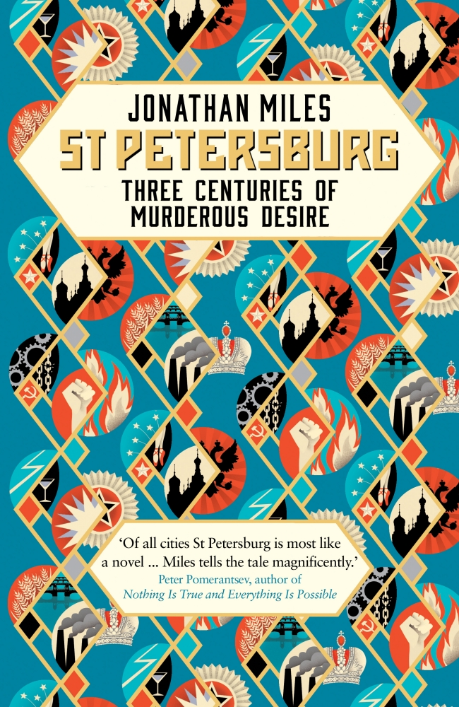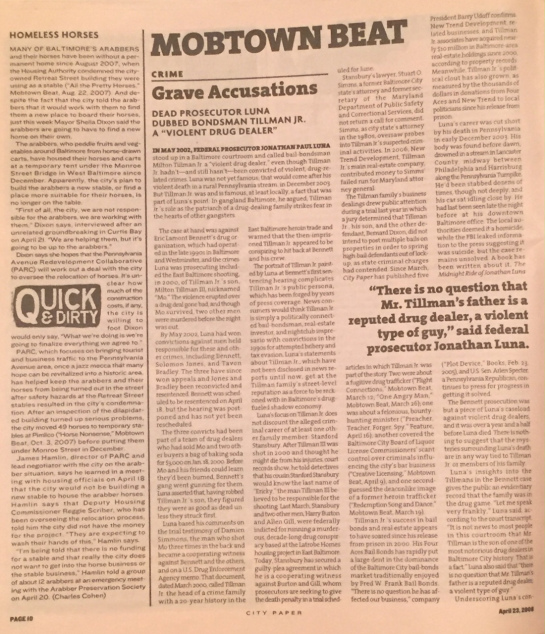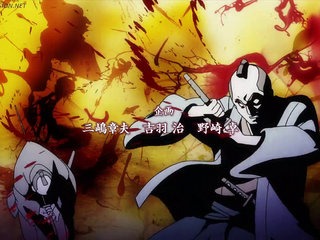
‘a glittering, cynical, witty and supremely absorbing story’
Hutchinson
Published 29th June 2017
608 Pages
ISBN-10: 0091959462
Read more at https://www.penguin.co.uk/books/1110266/st-petersburg/#T0xwoppgduGCwMzw.99
In terms of design this book is a work of art, complex Russian motifs run up and down the cover of the dust jacket, in the colours of red, white, blue and gold. I loved the cover so much that after a few days I took the grainy dust jacket off to read it. Already I could see wear occurring on the shimmering fake gold writing, white marks began to appear at the edges, as I took it around with me and dreaded it’s destruction. Yet underneath I found the accursed faux gilt on the spine, a major ware zone, and so baring in mind that dust jackets are there to protect what is underneath, I sacrificed the jacket even though I will likely never take it off. Oh beloved irony.
Miles approaches his preface with all the cynicism one would expect from a western writer. Yet at the same time using words that tell of a bittersweet love for his subject. The whispering tone seems to ask what changing element is St Petersburg currently oblivious to. As he walks up Nevsky Prospekt on a washed out summer day in 1993, Petersburg, he writes, was a stage built for its own play. The people who inhabited it gave it its character. For each generation put on an absurd, grandiose, brilliant production that puts on a show without betraying where the pulleys and trapdoors are hidden. Described as a window on Europe, St Petersburg has also been Europe’s window on Russia. A comforting and reassuring beacon of familiar civilisation for a perpetually mistrusted nation. The stage master smiles. As I read the predictably engaging preface, I thought, ‘this is also a window on St Petersburg, and part of the Russian identity’, and as it is a history it is the closest you might come to seeing the whole picture, because as with all good productions, the limes help you to see only what the director wishes.
The city that was built by Peter the Great, that mad and impressive autocrat who blended unquestionable power with the spirit of an Everyman. Who’d party all night and spit roast rebels, then battle a fire, hatchet in hand, march with his soldiers and cut wood for his own ships. However St. Petersburg was a strange place at the beginning, and it was not certain that it would last beyond the lifespan of its founder. Petersburg did have a troubled childhood. And for a time it looked as if Peter’s playhouse would become a ghost-town.In many ways Peter was almost a pantomime Tsar, who played a part and yet was a true visionary. The European city in Muscovite Russia built on a swamp prone to flooding could just have been the place he liked to play at being a European, and build ships. Yet just as the formidable Imperial Guard Regiments began life as living toy soldiers, St Petersburg was imbued with a lasting life that would ensure its survival. It would be a struggle, for even as Russia modernised it was still playing catchup. The state running both back and forward in time at the same time. St Petersburg was no different and is portrayed by the author as being glamorously out of step with the world it was meant to shine for. Peter’s modernisation, taking Russia into the 18th century, was a facade argues the author. It was like a second string tack star watching Usain Bolt, then putting on the Jamaican’s shoes and sprinting to catch up only to find out the obvious; change doesn’t happen overnight.
Film director Alexander Sokurov, creator of the sublime “Russian Ark” said at the turn of the 21st century that the Hermitage was the justification for the existence of St Petersburg. Which speaks something towards the city being an alter to culture. The passage of that film, (a work of which Miles would seem to be a fan), is mirrored by a substantial portion of this book. But Miles fills in the gaps that Sokurov could not cut away to, the squalor and the crime that made St Petersburg a true early modern city. Without a dark side, a place of ambition, of hopes, dreams, desperation, despair and avarice a city is an unreachable utopia, without a little murderous desire a city can hardly a city at all. It is a thorough history, but at times, perhaps inevitably, due to the status of Petersburg, one sometimes forgets that it is not a history of Russia since 1690. Certainly at the beginning it could easily be a history of the last 200 years of the Romanov dynasty.
Why is st Petersburg significant, as opposed to any other city? The World and Cold Wars stripped it of its political place alongside Paris and London. Perhaps it is because the city stands much as Madame de Stael saw it in 1811, as the visible proof of Russian ingenuity and genius. An old fashioned nation that decided to build a modern city on a swamp and in the course of a century had done so, proving everyone wrong. Building a city to rival the greatest achievements of their neighbours, just so they could point at Petersburg and say to all those European skeptics ‘Told you so.’ In the heyday of Tsarist power we see Peter found the unbuildable city, the empresses, most notably Anne and Catherine refine it to something admirable and by the death of Alexander I observe it to be as far advanced as it would become in terms of outside appreciation. At this moment St Petersburg was a Romanov jewel.
By part two, Miles, is able to draw upon the disenchanted author’s of the Decembrist era. The angst of a nation was reflected in its apparent superficiality and repressiveness, a metaphor the Tsarist state itself. He warms to his theme of a glittering but unsettling city that oozed as much as it sparkled. The body of writing concerning cities is indeed strange, because humanity loves to impute character onto inertia, bricks and mortar become uplifting or malevolent depending on the spirit of the times. Miles now is able to build on what he touched on at the start, the story of a city that is not what it seems. He hinted that St Petersburg had no soul for much of its life, and now outright confirms that it was a shallow thing that had been created at the whim of the moment, it was a glorious Potemkin town, a facade with nothing behind it, driven by excess and autocratic power, that in the opinion of one French visitor had betrayed Russian culture to ape that of the European, not unfairly, though snidely suggesting that as much of Russia could be seen in Paris as in St Petersburg.
This startling turn, presents us not with a glorious archivement of civilisation, but a Frankenstein’s monster of a city, made up of many parts belong to someone else. Indeed it frankly tells us that Petersburg’s only contribution to pure Russian culture was the fact that it could be built at all, the achievement itself was the only Russian thing about it. A harsh statement for so celibrated a centre, yet it cannot be denied that Petersburg, as a window to the west, transported light in both directions, and made it and Russia so absurd to Europe.
By the age of Revolution the facile and fragile facade of St Petersburg appears indeed as a great tsarist theatre-set that the world could admire and that the emperor’s, the greatest players of the world stage, could play upon. However it also covered up the weaknesses and contributed to their fall. That the flourishing of the city would also sow the seed of Revolution, and in hindsight from this moment it seems impossible for the Tsars to save themselves, at least as they wished to continue. At times it seems that the only constant and relatively stable thing to come from St Petersburg was the theatres and art that it birthed, no matter what cataclysm has just occurred, the theatres of the city and its writers continued on their seemingly unstoppable march, or more accurately their dance, into the future, art indeed remains the greatest legacy of St Petersburg as a Capitol city.
I haven’t read enough ‘urban biographies’ to know what such a thing should be. All I can say is this one concentrates on the evolution of the city and the people and culture that could be found within it. It seems proper, though at times it seem like the city isn’t there at all, but then sometimes the scenery of a play seems only incidental to the act then occurring, but without which it would be both pointless and absurd. 300 years of murderous desire is a work of great technical skill, written with joyously vivid and rich language that allows you to progress with a desire for more. Much like a Tolstoy novel, (one of the few Russian writers not to play a large part in this book), the cast is too vast to name. Which means that when reading this book, a work of such sweeping proportion, opens so many doors to the inquisitive mind.
If the city can be seen as somehow an allegory of Russia’s march to modernity then a few things can be observed, at least in this narrative. Russia is able to modernise and modernise quickly, often however practicalities lag behind. The tsars accelerated the pace of change and built St Petersburg, having just about reached a shaky parity in art and civilisation with Europe by the fall of the dynasty. The actual welfare of the people would remain little better than medieval until the Communists declared another acceleration which in sum did almost exactly the same thing and created an autocracy out of a democracy. Built on a Tsarist foundation a workers ‘utopia’ with exactly the same values regarding power and security was formed. Unlike the Tsars however, who could at least be argued to have been ordained by God the communist system was a fragile thing based on ideas and half fulfilled promises. If history teaches us anything it is that autocracy tends to be a statistically long lived model of government, the communists weren’t given over 300 years to smooth out the wrinkles, when they got it wrong they continued to trip until they fell. The experiment eventually outran its legs and today, Russia, we seem to observe, is running forwards again, as a socialist democracy this time on top of a communist model. By the death of Stalin one begins to wonder if Russia might as well have remained under the rule of Tsars. Once more the author brings us back to St Petersburg, through architecture, ideas and art. St Petersburg was the cradle of Revolution. The first was that instigated by Peter the Great, then the Decembrists and then in 1917. The history of the communist party in Russia is the history of its fall. As soon as it began, as soon as the hatred for the Tsars was replaced by the fear for the central government, it seemed, like the Romanov’s after the Decembrist revolt to be doomed. It seems as if they were on the cusp of reaching stability just before the end. Today most simple Russians you see on TV over 50 will speak fondly of the Soviet days, pointing out a fondness for the state welfare system that the west freely sneers at, and disillusioned people in their 40’s who welcomed capitalism in the 1990’s now glumly also harken back to the old days and complain they didn’t sign on for what they have got.
The siege of Leningrad portion, enlightening. A chapter written it seems to the best of Shastekovitch’s 7th symphony, the image of its strident notes carrying tinnily from the loud speakers across the lonely stretch of no man’s land to the German trenches, where Hitler’s infantry heard it and realised Leningrad would never fall, will not be erased from my memory. Coming to this book I wondered about what of St Petersburg is original, as much of what one hears about the siege suggests nothing survived. I wondered if this tsarist Potemkin town, is a Potemkin town of itself. It was one of my big questions about St Petersburg. For both the Tsars and the Commissars the proof lay in the pudding, the long lines of Decembrists and rebels told of the oppression of the Romanov’s, and the longer endless trails of political enemies all lead to Siberia.
And what of Russia today, where does its road lead? A nation once more racing to catch up with 100 years of capitalist democracy, constantly being criticised for not running fast enough when perhaps she should be advised to slow down and find her own pace. How much has changed since the Volga delta was marshland and how little. Why indeed borrow Europe’s mistakes. All at once the west cries that Russia should look to them, as if that isn’t what they’d been doing for the last 400 years behind the veneer of bettering it in the name of Russianness. The first 216 pages and the last 130 pages are perhaps the most crucial to the greatness of the city, its time of ferment and change occurring in the intervening passages. It’s almost as if the author wants it to be a proper European city, his caustic mistrust of the current government fits in neatly with his own picture of how Europeans have viewed Russia for centuries. The Petersburg he paints by the time of the breathless finish is a Potemkinised creation, and at its heart it is unchanged from the mirage like dream that Peter built on a mound of workers’ corpses. When people come back from St Petersburg and call it a Fairytale City they don’t know the half of it. This is a glittering, cynical, witty and supremely absorbing story of the building a European city in Russia that birthed the heart of modern Russian culture. It is a book that you will not forget in a hurry.
Josh.
Share this on:




